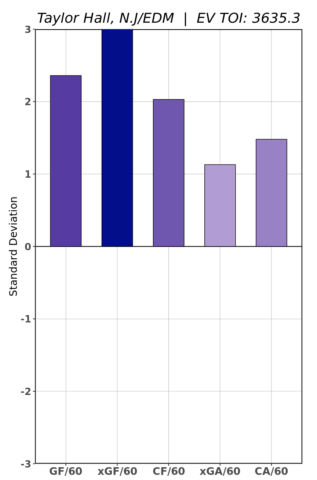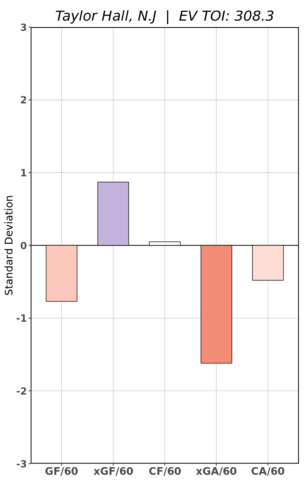It’s been quite the odd start to the 2019-20 season for New Jersey Devils’ winger Taylor Hall. He’s slated to become an unrestricted free agent in July 2020. And there are no indications he’s ready to sign a lucrative, long-term extension with the team, a process that seems it’ll drag on for the foreseeable future.
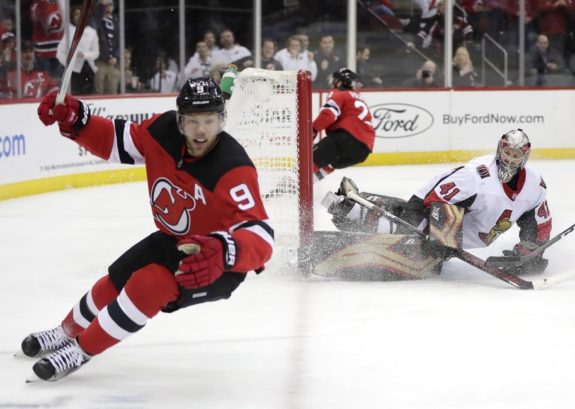
While it’s close to impossible to say if that’s impacting his on-ice performance, Hall hasn’t looked quite like himself in the early goings of the season. Despite leading the team with 17 points in 20 games, he has only two goals, and his underlying numbers are not what they’ve been in previous seasons. So should the Devils be concerned with their star player?
Hall’s Two-Way Game Has Slipped
Since the Devils acquired Hall in 2016, he’s been one of the top wingers in the NHL. He won the Hart Trophy as the league’s MVP in 2018, with 93 points in 76 games, which helped the Devils qualify for the playoffs for the first time since 2011-12. He looked like he was on pace to equal his point totals in 2018-19, with 37 points in 33 games, before a knee injury knocked him out for the rest of the season.
Hall entered training camp healthy and looking to rebound after barely playing a season ago. He’s on pace to finish with 70 points in 82 games. But his even-strength stats aren’t what you’d expect from him — he has a 49.10 Corsi for percentage (CF%) and 48.03 expected goals for percentage (xGF%) when on the ice. However, what’s most concerning is the dramatic dropoff in Hall’s two-way game.
Below are RAPM charts, which show a player’s impact on a stat by stripping outside factors like opponents and teammates, from Evolving Hockey. The one on the left is from 2016-2019, while the one on the right is for this season. The first three columns (GF/60, xGF/60, CF/60) are offensive metrics, while the last two (xGA/60, CA/60) are defensive metrics. The darker orange shows Hall’s negative impact on expected goals against per 60 minutes (xGA/60), as well as a negative impact on shot attempts against per 60 minutes (CA/60).
Compared to the chart on the left, the decline in his defense is quite noticeable, and the same is true of Hall’s offensive metrics. While they’re a bit better than his defensive ones, they’re still way off compared to where they were from 2016-2019, as well. So what’s the explanation for his dropoff?
Related: Ranking Every Hart Trophy Winner Since 2005
One could be Hall’s had two major knee injuries since 2016-17 — having torn his meniscus in that season — both of which he’s had surgery to repair. He also had torn ligaments in his hand during 2017-18 but played through it for a good part of the season. At 28 years old, it may be taking a bit of a toll on him, and that’s not a great sign when a player gets closer to his 30s.
Hall’s Getting Unlucky, but It’s Not That Simple
Hall may not be playing up to what he expects of himself, but he’s also been the victim of some bad luck. He’s still creating a ton of shots and chances, but he hasn’t been able to buy a goal. To date, he leads the team in even-strength shots on goal, shot attempts, scoring chances, and high-danger chances but has just two goals to show for it.
Considering the volume and quality of shots Hall has created, he ends up with an individual expected goals (ixG) of 3.95 at even-strength — that numbers increases to 5.73 at all strengths. His shooting percentage at all strengths stands at 2.8% for the season, and he’s a 10.8% shooter for his career, so he’s due to score.
And if Hall keeps playing with the linemates he is, he should pot one at some point. For the last three games, he’s played with Nico Hischier and Jesper Bratt, two forwards he’s had success with in the past. When he’s not with those two, he’s played with either Hischier and Kyle Palmieri or Jack Hughes and Palmieri.
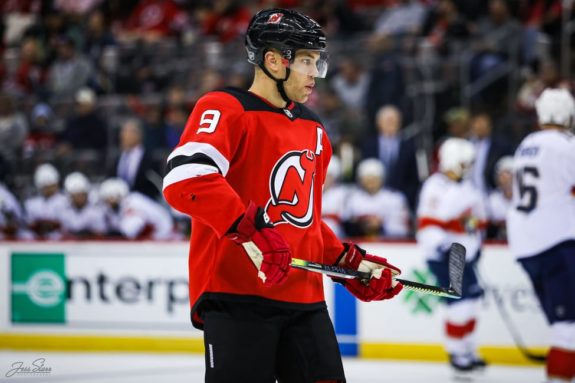
He may have plenty of talent around him, but there is still reason to be concerned. Hall’s goals above replacement (GAR), which shows how many goals a player adds to his team relative to a replacement-level player, is minus-0.4. In Evolving Hockey’s GAR model, the impact on even-strength offense (EVO) is one of the main components determining GAR. In Hall’s case, his EVO is minus-0.1 through 20 games. It was 5.3 in 33 games last season, while it was 15.8 during his Hart Trophy campaign in 2017-18.
Related: Devils Ready for a New Look in Net
For comparison’s sake, Pavel Zacha’s EVO is 2.8, while Blake Coleman’s is 2.5, the top two rates on the team for 2019-20. They’re both fine players, but Hall is supposed to be the Devils’ best player when it comes to impacting even-strength offense, and his EVO is ranked 14th on the team. So it’s clear there’s room for improvement.
Where Do Hall and the Devils Go From Here?
It isn’t time to raise the panic button on Hall’s start to 2019-20 just yet, but it does bear watching. We’re only 20 games into the season, so there’s plenty of time for things to reverse course. But he has not looked like the same player he did during his MVP season or even the start of 2018-19 before his injury.
It’s fair for general manager Ray Shero to be concerned about Hall, but I would bet on him bouncing back at some point. With that said, it seems increasingly likely the Devils end up trading Hall before the Feb. 24 Trade Deadline. His slow start may hurt his trade value a bit, which throws a curveball in how it affects the Devils. The slow start also makes the prospect of signing him to an eight-year extension look less appealing, especially if it’s the start of an age-related decline.
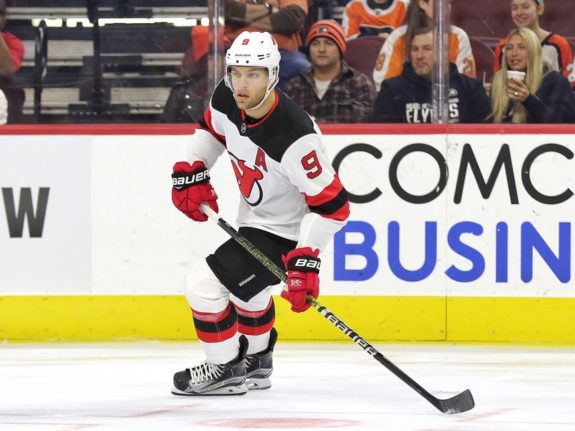
That could make trading Hall Shero’s best option, specifically if it’s a sign-and-trade scenario similar to the Vegas Golden Knights’ acquisitions of Max Pacioretty or Mark Stone. And even if they trade Hall as a pure rental, getting something in return (a top prospect and first-round pick at a minimum) would be better than losing him for nothing as a free agent. If that happens, then the Devils could be in a lot worse shape than they are right now.
* * *
Advanced stats from Natural Stat Trick
